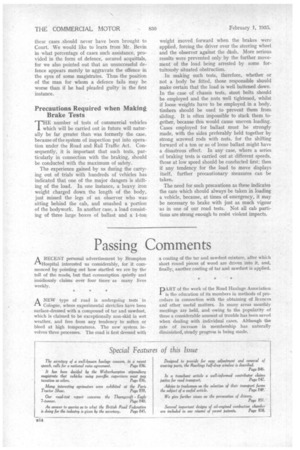Precautions Required when Making Brake Tests
Page 24

If you've noticed an error in this article please click here to report it so we can fix it.
THE number of tests of commercial vehicles which will be carried out in future will naturally be far greater than was formerly the case, because of the system of inspection put into operation under the Road and Rail Traffic Act. Consequently, it is important that such tests, particularly in connection with the braking, should be conducted with the maximum of safety.
The experience gained by us during the carrying out of trials with hundreds of vehicles has indicated that one of the major dangers is shifting of the load. In one instance, a heavy iron weight charged down the length of the body, just missed the legs of an observer who was sitting behind the cab, and smashed a portion of the bodywork. In another case, a load consisting of three large boxes of ballast and a l-ton weight Moved forward when the brakes were applied, forcing the driver over the steering wheel and the observer against the dash. More serious results were prevented only by the further movement of the load being arrested by some fortuitously situated obstruction.
In making such tests, therefore, whether or not a body be fitted, those responsible should make certain that the load is well battened down. In the case of chassis tests, stout bolts should be employed and the nuts well tightened, whilst if loose weights have to be employed in a body, timbers should be used to prevent them from sliding. It is often impossible to stack them together, because this would cause uneven loading. Cases employed for ballast must be strongly made, with the sides preferably held together by strong screwed rods with nuts, for the shifting forward of a ton or so of loose ballast might have a disastrous effect. In any case, where a series of braking tests is carried out at different speeds, those at low speed should be conducted first; then if any tendency for the load to move displays itself, further precautionary measures can be taken.
The need for such precautions as these indicates the care which should always be taken in loading a vehicle, because, at times of emergency, it may be necessary to brake with just as much vigour as in one of our road tests. Not all cab partitions are strong enough to resist violent impacts.




















































































